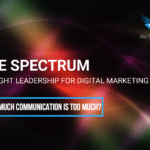Every company has a brand, and if you haven’t defined yours then your competition is probably doing it for you. Allowing your competitors to define you in the marketplace is a dangerous omission in marketing strategy.
In this Part 1, we cover the five elements of our Brand DNA model.
If you aren’t actively managing your brand, chances are your competition is doing it for you!
We can all agree that branding has value in consumer markets, but what about industrial markets? In the Harvard Business Review, James R. Gregory and Donald E. Sexton published a study, Hidden Wealth in B2B Brands, covering 450 companies in 47 industries over 16 years. They found that brand equity – their measure of brand value – accounted for up to 7% of stock performance for industrial companies.
That is a significant number when you consider the size of some of the largest public industrial companies, and we suspect that it might be higher for small and medium-sized businesses with less access to capital markets.
Our Brand DNA Model
Just like DNA is found in every one of your cells, we make sure that your Brand DNA is embedded in every marketing asset and communication, from your website to marketing collateral, LinkedIn posts, trade show graphics, pitchbooks, videos, white papers, case studies, advertisements and more.
Every consulting firm and agency has their own idea of what a brand is. Our Brand DNA concept is based on five factors:

Brand Promise. Your Brand Promise is the one thing that you promise to deliver to your clients or customers. It is the experience that buyers want to experience time and again and is a combination of your Core Competency and Value Proposition.
Example: EcoVapor Recovery Systems offers technology-based solutions for eliminating routine flaring and emissions. Their Brand Promise of Pathways to Zero quickly and efficiently communicates to their target audience of oil and gas producers that they can help them achieve net-zero emissions.
The Brand Promise from Streamline Innovations, Eliminating Pollution Through Technology, perfectly sums up what their technology does while also positioning their solutions for treating hydrogen sulfide as environmentally friendly.
Brand Position. Your Brand Position is where you sit on the competitive landscape. There are a variety of tools to use when evaluating your competitive position, but in general the most important thing to define here is what makes your company and solutions different.
Example: Turning again to EcoVapor, there are several solutions for reducing routine flaring at oil and gas production sites, but what makes the company’s solutions stand out from other environmental solutions is that they also make money. The phrase “You don’t have to choose between achieving environmental performance goals and financial results, with EcoVapor you can do both” effectively communicates what makes EcoVapor different and in most cases, better.
Brand Story. In our experience, the Brand Story is one of the most overlooked parts of Brand DNA and offers some low-hanging fruit for marketers. Your Brand Story is not a chronological timeline, it is concise description of how you got into your business and importantly why you are passionate about the problems you are solving. The Brand Story lets you connect the dots between your Core Competency, Brand Promise and Value Proposition in a human way.
We will provide more examples of effective Brand Stories in future blog posts.
Brand Associations. A Brand Association is a mental connection between your brand and a concept. Brand Associations are thoughts that pop to mind when a person thinks about a brand, such as “soft” for Cottonelle or “athletics” for Nike. It also has implications with the kinds of events you sponsor and attend. Your Brand Associations inform the market about your values, assumptions about the world and motivations. People generally like to buy from people they like, and Brand Associations demonstrate that you have something in common with your target market.
Brand Personality. Your Brand Personality is what most people associate as a “brand,” being a combination of your logo, brand colors, font choices, word choices, product/service names and writing style. Most clients who first approach us already have a developed Brand Personality, but we do work with startups and companies looking to re-brand.
Heart and Mind
At the highest level, your Brand DNA is a synthesis of emotion and logic, heart and mind. People want to buy from those who can deliver on their Brand Promise, who have a passionate Brand Story, who are confident in their Brand Position, and who share similar Brand Associations while having an appealing Brand Personality.
Defining those elements makes for a powerful Message Platform and one that is above all, honest. Buyers today are smart, and even if they do not know everything about you, they are only a few clicks away from learning everything that they think they need to know about you.
Brand DNA is about making sure what the market learns about your company is what you want them to learn.
Stay tuned! In Part 2, we will cover how your Brand DNA translates into messaging for your website, marketing materials, emails, sales decks, social media and all market-facing communications.
Let’s Talk! Schedule a free 30-minute Digital Marketing consultation to see if there is a fit between your marketing challenges and our capabilities.
About Prism Group
Prism Group is a full-spectrum, multi-talented B2B agency focused on Energy Tech, Technology, Energy, Services and Media markets. Our work is telling stories that matter, because our clients are working to change the world for the better. What makes us different is that we put into action the strategies we recommend – we get it done, so you can get results and increase the value of your business.
Contact
James Constas
President
Prism Group
JConstas@1PrismGroup.com









